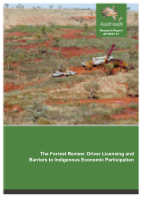Registration and Licensing

- Publication no: AP-R537-17
- ISBN: 978-1-925451-56-6
- Published: 14 February 2017
- PDF (free) Download
The Forrest Review recommends that all Australian State and Territory Governments “introduce a consistent approach to issuing ‘provisional’ locked licences for people who are unable to drive due to unpaid fines or other traffic infringements, so that they can get and keep a job by being able to drive.” The objective of this measure would be to address barriers to employment experienced by Indigenous people whose driver licences are subject to suspension, cancellation, or other sanction.
This report finds that the following measures are already in place at State and Territory level allow people whose licences are subject to suspension to keep their licences, either for employment or any other purpose:
- the ‘Period of Good Behaviour’ option (under which a driver who has lost all of their demerit points can continue to drive, subject to good behaviour conditions)
- the ‘Time to Pay’ option (under which a driver can continue to drive while outstanding fines are repaid by instalments).
These options are already offered in a relatively uniform manner across all of the State and Territory jurisdictions and appear to largely achieve the objectives of this recommendation of the Forrest Review.
The report finds that there may be scope for State and Territory Governments to raise awareness and improve access for Indigenous people to these options. It also finds that States and Territories should work together to develop national policy principles for Indigenous driver licence service delivery and seek authority for these national policy principles from the Transport and Infrastructure Council.
While terminology varies, some State and Territory courts can order the provision of a ‘locked’ licence (that is, a conditional licence issued to a driver for whom a court-ordered suspension or disqualification would cause hardship, such as loss of employment). Unlike the Period of Good Behaviour and Time to Pay measures, the use of locked licences is not consistent across jurisdictions. Furthermore, policy for court orders of this kind generally involve justice portfolios or other government agencies beyond transport departments. This report documents the locked licence arrangements in place in each State and Territory. However, because a national approach to these measures would involve action beyond transport policy responsibilities, no findings or recommendations on locked licences are made.
The report also documents general programs and initiatives in place at State and Territory level to promote Indigenous access to driver licences.
- Summary
- 1. Creating Parity–The Forrest Review
- 1.1. Recommendation 15: ‘Locked’ licences
- 1.2. The Response to Recommendation 15
- 1.2.1. Austroads
- 1.2.2. This Report
- 1.2.3. Consultation
- 1.2.4. Road Safety Outcomes
- 1.2.5. Broader Policy Context: ‘Closing the Gap’ and the ‘Building Blocks’ Approach
- 2. Feedback from Stakeholders
- 2.1. Community Organisations
- 2.2. Government Service Providers
- 3. Indigenous Driver Licensing Programs
- 4. Period of Good Behaviour
- 5. Time to Pay
- 6. Court-Ordered Restricted Licences
- 7. Opportunities for Enhancement
- 8. Recommendations
- Appendix A Indigenous Driver Licence Programs
- A.1 New South Wales
- A.1.1 Driving Change
- A.2 Northern Territory
- A.2.1 DriveSafe NT Remote
- A.3 Queensland
- A.3.1 Indigenous Driver Licensing Unit
- A.4 South Australia
- A.4.1 On the Right Track Remote
- A.5 Victoria
- A.5.1 L2P Learner Driver Mentor program
- A.6 Western Australia
- A.6.1 Remote Areas Licensing Program
- A.6.2 Royalties for Regions: Enhanced Driver Training and Education Program
- Appendix B Period of Good Behaviour
- B.1 Australian Capital Territory
- B.2 New South Wales
- B.3 Northern Territory
- B.4 Queensland
- B.5 South Australia
- B.6 Tasmania
- B.7 Victoria
- B.8 Western Australia
- Appendix C Time to Pay
- C.1 Australian Capital Territory
- C.2 New South Wales
- C.3 Northern Territory
- C.4 Queensland
- C.5 South Australia
- C.6 Tasmania
- C.7 Victoria
- C.8 Western Australia
- Appendix D Court-ordered Restricted Licences
- D.1 Australian Capital Territory
- D.2 New South Wales
- D.3 Northern Territory
- D.4 Queensland
- D.5 South Australia
- D.6 Tasmania
- D.7 Victoria
- D.8 Western Australia
